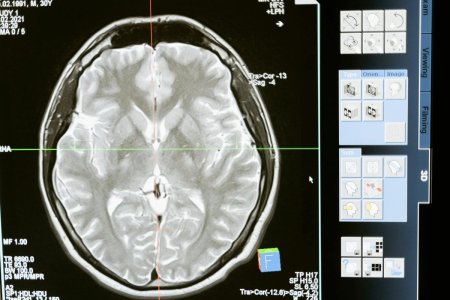Can a quick hand movement reveal a hidden health issue? Here’s what to know about this simple brain check
By
Veronica E.
- Replies 0
Disclaimer: The information provided in this article is for educational purposes only and is not intended as a substitute for professional medical advice, diagnosis, or treatment. Always consult your physician or other qualified healthcare providers with any questions you may have regarding a medical condition or before making any changes to your health regimen.
We all hope to catch health issues early—but knowing what to watch for isn’t always clear-cut.
That’s why a simple 30-second hand test is getting attention for potentially spotting neurological changes, including—though rarely—early signs of a brain tumor.
At The GrayVine, we believe in sharing helpful, science-informed tips that anyone can try at home.
While this test isn't meant to diagnose anything on its own, it could offer a gentle nudge to check in with your doctor if something feels off.
Let’s walk through what the test involves, what it might show, and how to respond if something doesn’t feel quite right.

This quick self-check is something you can try at home right now. Here’s how to do it:
Doctors call this a "rapid alternating movement."
They often use it to look for a sign called dysdiadochokinesia—a term that refers to difficulty performing fast, alternating motions.
If one hand is noticeably slower or more awkward than the other, it may be worth mentioning to your healthcare provider.
The cerebellum, a small region near the base of the brain, helps control coordination and balance.
When something affects this area—such as a stroke, a neurological condition, or, in rare cases, a brain tumor—it can interfere with movements like the one in this test.
But let’s be clear: struggling with this motion doesn’t mean you have a tumor.
It simply means that your coordination isn’t quite balanced between both hands, and there may be an underlying reason worth exploring.
Several things—not just tumors—can affect this type of motion, including:
This test recently gained attention after a woman shared a video of her partner—who has a slow-growing brain tumor—struggling with the movement.
The video caught on quickly, prompting discussions about early signs of neurological changes.
Medical educators have since explained the test online, noting that it’s a useful check-in.
According to some experts, "everyone should be able to do it."
If you can’t, or if one hand moves much less smoothly, that’s something to bring up during a medical visit.
Source: TikTok / Medifectious
Brain tumors are relatively rare but can be serious.
Even non-cancerous growths can cause harm if they press on sensitive brain areas.
Here are some symptoms that may point to a neurological issue:
Keep in mind: many of these symptoms can come from much less serious causes, so noticing one or two doesn’t automatically mean something severe.
Most people who find the test difficult do not have a brain tumor.
Age-related changes, arthritis, or even unfamiliarity with the motion can all make the movement harder.
What matters more is whether the change is sudden, getting worse, or accompanied by other symptoms.
This hand test isn't a diagnostic tool, but it can serve as a quick check-in with your body.
If you notice that your coordination seems off, especially if it's new or paired with other changes, trust your instincts and talk to your doctor.
Sometimes the smallest signs help catch issues early—and early care makes a difference.
Read next:The surprising link between your teeth and a healthy heart and brain—what dentists wish you knew

We’d love to know what you think. Did you give it a try? Did you notice anything different? Feel free to share your experiences in the comments—it might just help someone else stay ahead of a health concern.
We all hope to catch health issues early—but knowing what to watch for isn’t always clear-cut.
That’s why a simple 30-second hand test is getting attention for potentially spotting neurological changes, including—though rarely—early signs of a brain tumor.
At The GrayVine, we believe in sharing helpful, science-informed tips that anyone can try at home.
While this test isn't meant to diagnose anything on its own, it could offer a gentle nudge to check in with your doctor if something feels off.
Let’s walk through what the test involves, what it might show, and how to respond if something doesn’t feel quite right.

The brain plays a key role in balance and coordination—changes in these areas can sometimes signal underlying health issues. Image Source: Pexels / MART PRODUCTION.
What is the 30-second hand test?
This quick self-check is something you can try at home right now. Here’s how to do it:
- Place one hand palm-down on top of your other hand.
- Flip the top hand over quickly—palm up, then palm down—back and forth several times.
- Switch hands and repeat the movement.
Doctors call this a "rapid alternating movement."
They often use it to look for a sign called dysdiadochokinesia—a term that refers to difficulty performing fast, alternating motions.
If one hand is noticeably slower or more awkward than the other, it may be worth mentioning to your healthcare provider.
Also read: Brain health secrets: How to flush out "brain waste" and protect your mind
What does the test check for?
The cerebellum, a small region near the base of the brain, helps control coordination and balance.
When something affects this area—such as a stroke, a neurological condition, or, in rare cases, a brain tumor—it can interfere with movements like the one in this test.
But let’s be clear: struggling with this motion doesn’t mean you have a tumor.
It simply means that your coordination isn’t quite balanced between both hands, and there may be an underlying reason worth exploring.
Also read: Boost your brain on-the-go: Discover the 5 surprising snacks RDs swear by!
What else can cause difficulty?
Several things—not just tumors—can affect this type of motion, including:
- Brain lesions from strokes or injuries
- Nerve-related conditions like multiple sclerosis
- Parkinson’s disease or other degenerative illnesses
- Alcohol intoxication (even short-term effects)
Why people are talking about it
This test recently gained attention after a woman shared a video of her partner—who has a slow-growing brain tumor—struggling with the movement.
The video caught on quickly, prompting discussions about early signs of neurological changes.
Medical educators have since explained the test online, noting that it’s a useful check-in.
According to some experts, "everyone should be able to do it."
If you can’t, or if one hand moves much less smoothly, that’s something to bring up during a medical visit.
Source: TikTok / Medifectious
Also read: Neurologists urge: Quit this harmful habit for better brain health
Understanding brain tumors
Brain tumors are relatively rare but can be serious.
Even non-cancerous growths can cause harm if they press on sensitive brain areas.
Here are some symptoms that may point to a neurological issue:
- Frequent or worsening headaches
- Morning nausea or vomiting
- Vision or speech changes
- Drowsiness or confusion
- Weakness or numbness on one side
- Personality or behavior changes
Keep in mind: many of these symptoms can come from much less serious causes, so noticing one or two doesn’t automatically mean something severe.
Should you be concerned?
Most people who find the test difficult do not have a brain tumor.
Age-related changes, arthritis, or even unfamiliarity with the motion can all make the movement harder.
What matters more is whether the change is sudden, getting worse, or accompanied by other symptoms.
Also read: Are you ignoring this "mini" health issue? New study reveals it could be killing your brain cells!
What to do if something feels off
- Don’t panic—many harmless conditions can affect coordination.
- Pay attention to any new or worsening symptoms, like headaches or dizziness.
- Reach out to your healthcare provider to discuss your experience.
- Make note of when symptoms began and how they’ve progressed.
This hand test isn't a diagnostic tool, but it can serve as a quick check-in with your body.
If you notice that your coordination seems off, especially if it's new or paired with other changes, trust your instincts and talk to your doctor.
Sometimes the smallest signs help catch issues early—and early care makes a difference.
Read next:The surprising link between your teeth and a healthy heart and brain—what dentists wish you knew
Key Takeaways
[LIST
[*] A 30-second hand test may help identify early coordination problems that could signal an issue with brain function.
[*] The test involves quickly flipping one hand palm up and down over the other, then repeating with the opposite hand.
[*] Difficulty completing the motion—called dysdiadochokinesia—can be linked to issues in the cerebellum, including tumors or neurological conditions.
[*] Experts recommend seeing a doctor if you notice new or worsening symptoms like headaches, vision problems, or coordination changes, even though these signs don’t always point to a tumor.
[/LIST]
[*] A 30-second hand test may help identify early coordination problems that could signal an issue with brain function.
[*] The test involves quickly flipping one hand palm up and down over the other, then repeating with the opposite hand.
[*] Difficulty completing the motion—called dysdiadochokinesia—can be linked to issues in the cerebellum, including tumors or neurological conditions.
[*] Experts recommend seeing a doctor if you notice new or worsening symptoms like headaches, vision problems, or coordination changes, even though these signs don’t always point to a tumor.
[/LIST]
We’d love to know what you think. Did you give it a try? Did you notice anything different? Feel free to share your experiences in the comments—it might just help someone else stay ahead of a health concern.






